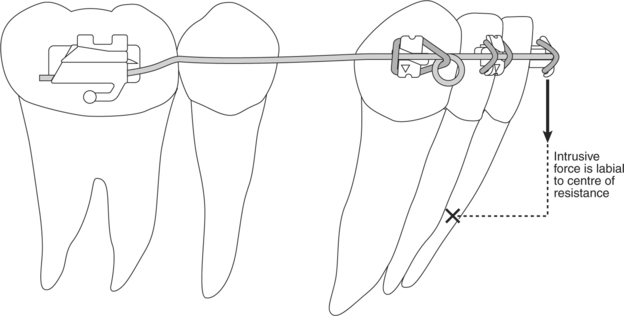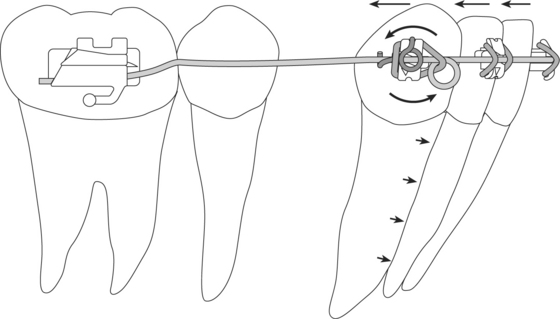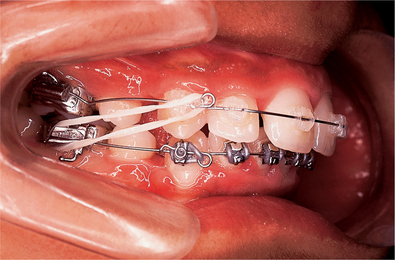CHAPTER 10 ‘Power Tipping’ and the Protraction Arch
Here are two techniques that are sometimes useful during Stage I to counteract specific problems. They are unrelated except inasmuch as they usually involve the lower labial segment. Power Tipping is a way of resisting lower incisor proclination during overbite reduction in extraction cases, or where the buccal segments are spaced. It is also able to upright incisors lingually over mandibular base with minimal loss of anchorage.
Power Tipping
The situation becomes more threatening, however, when the overbite is being reduced with an already proclined lower incisor segment. Here, by the simple laws of physics, it will be understood that the intrusive force from an archwire within a labially placed bracket acts along an axis that will be considerably labial to the centre of rotation of a proclined incisor (Fig. 10.1). If further proclination is to be avoided, a lingual component of force must be introduced to counteract the proclination. How might this be done?
In a conventional edgewise derived bracket, lingual incisor crown torque might be induced by means of a torqued rectangular archwire, assuming that the anteriors are sufficiently aligned to permit full bracket engagement. However, Tip-Edge brackets cannot achieve third-order torque against rectangular wire while in transitional angles of tip. It would, of course, be easy enough to generate lingual crown movement by the simple expedient of adding intramandibular traction along the arch, but this would introduce a reciprocal mesial force to the lower first molars, thereby dragging molar anchorage.
How does it work?
Power Tipping utilizes ‘reverse Side-Winder springs’ to induce distal crown torque to the lower canines, and hence distal retraction, which in turn uprights the lower anterior segment lingually (Fig. 10.2). It is essential to ligate the canine brackets to the cuspid circles during this process, assuming the anterior teeth are in alignment; otherwise the canines will retract along the arch without taking the lower incisors lingually, like a locomotive leaving its train behind. Obviously, use of Power Tipping presupposes that there is available space in the arch to the distal, into which the canines can migrate. If not, mesial root movement of the canines will result, instead of the distal crown movement intended. Power Tipping can be applied at any time during Stage I, when it becomes apparent that unwanted proclination is developing during overbite reduction. It does not require modification of the archwire.
The clinical scenario illustrated (Fig. 10.3) shows Stage I in progress during the treatment of a 12 mm overjet with a complete overbite in which the lower incisors were initially proclined. They now threaten to procline further under the intrusive influence of the anchorage bends, coupled with the use of Class II elastics. Four premolars have been extracted and the Stage I assembly is as described in previous chapters, using .016 inch high tensile stainless archwires with anchor bends to the round buccal tubes. The premolars are omitted.
Stay updated, free dental videos. Join our Telegram channel

VIDEdental - Online dental courses





